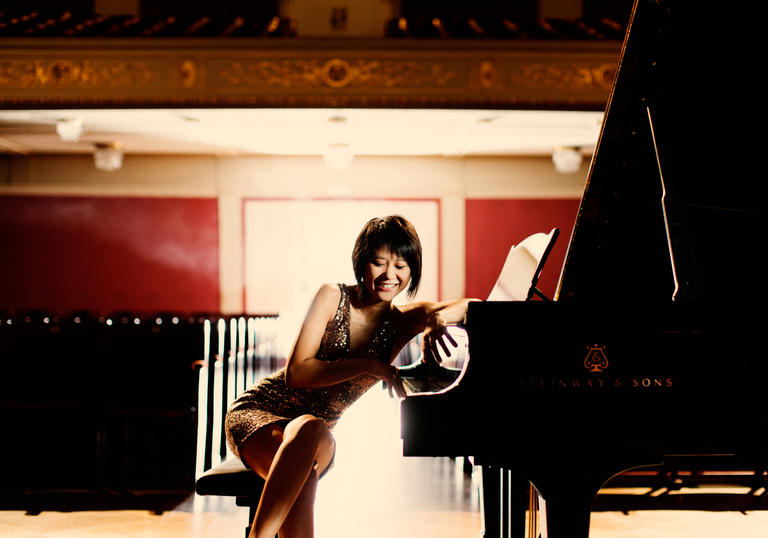In 1902 conductor Oskar Nedbal wrote, ‘this is the first time that an orchestra from the Continent has settled in London for a longer period of time…’ He was writing about the Czech Philharmonic’s residency in May–June that year. More than a hundred years (and several visits) later, the Czech Philharmonic brings its repertoire again to London for these two concerts at the Barbican.
This residency begins with a work by Russian composer Sergei Rachmaninov, then newly graduated from Moscow Conservatory. The composer premiered the first movement of this work in spring 1892 but was never quite satisfied with it as it stood. A quarter-century later, after writing his Second and Third Piano Concertos, he settled himself in his flat on Strastnoy Boulevard, Moscow, and began the long-sought revisions. It was 1917 but Rachmaninov blocked out the Revolutionary turmoil around him.
Rachmaninov’s changes were quite extensive, but the concerto still balances the extraordinary virtuosity and a romantic lyricism that was characteristic from early on. These two sides can be heard, for example, in the first movement, where, after a brass statement combined with cascading piano double octaves, the orchestra launches into the broadly lyrical main theme. Shortly thereafter the piano’s scherzando passage gives rise to the second main theme, an almost-importuning rising violin theme.
The Andante has the mood of a nocturne. After an extensive solo, the other instruments comment on the soloist’s musings until the violins draw an alluring melody out of what was merely implied by bassoon. The third movement saw the greatest overhaul in the 1917 revision. If anything, the mercurial exchanges between soloist and orchestra became more extreme, and, paradoxically, more purposeful. Perhaps the biggest change is a highly accented Russian dance to close, where previously there had been a grandiose transformation of an earlier lyrical passage.
Shortly after completing this work to his satisfaction, Rachmaninov received an invitation to perform in Stockholm. The Piano Concerto No 1 was the last major work he composed before leaving Russia permanently. He would express hurt, in later years, when it was clear US promoters preferred his second and third concertos.
Smetana’s Ma vlást is a cornerstone of Czech repertoire. Though inspired by the Lisztian ideal of the symphonic poem – a composition following the logic of an extra-musical reference source – Smetana only slowly came to the idea of a cycle of ‘poems’ extolling his homeland. He had concentrated on opera upon returning from Sweden in 1861.
The first ‘poem’ – ‘Vyšehrad’ – was completed in November 1874 and premiered on 14 March 1875. Portraying the mythical birthplace of Prague, the legendary and historical fortress which stands on a rock east of the river Vltava, the piece begins with a solo harp playing the ‘Vyšehrad motif’. As Smetana said, ‘a poet sings of the events on Vyšehrad, of glory and splendour, of tournaments and battles, and of eventual decline and ruin. The poem ends on an elegiac note.’
Leoš Janáček, whose Glagolitic Mass climaxes this residency, described the reaction to Smetana’s second poem ‘Vltava’ when in 1875 he first heard it: “At the end a tumultuous roar fused into the name Smetana!” ‘Vltava’ is the most popular of Ma vlást’s movements. It depicts the course of the mighty Czech river (in German: ‘Moldau’) that flows through much of Bohemia, from its source as two rivulets, past a woodland hunt, peasants’ wedding, and mermaids in moonlight, to St. John’s Rapids. The ‘river’ theme blazes forth in major mode, setting up a victorious return to Vyšehrad, before fading away. The Vltava eventually joins the Elbe.
The third movement depicts the legend of Šárka who avenged herself on men for an earlier infidelity. We hear the approach of Ctirad and his men, the cry of anguish Šárka feigned to lure Ctirad’s men to her maidens’ trap, love music, carousal, slumber and then a horn, Šárka’s signal to start the massacre. ‘From Bohemia’s Woods and Fields’, denotes Smetana’s love of the Bohemian countryside. He basks in generous melody though making prominent use of fugue.
By 1878, Smetana had decided to expand his original concept (a tetralogy) to six movements, ending with a pair inspired by the Hussite period in Czech history. Both make use of ‘Ye who are God’s Warriors’, a hymn that supposedly struck fear in the enemy. ‘Tábor’, named after the Hussite stronghold, depicts the Hussites’ faith and resolve. ‘Blaník’ refers to the hill under which Czech warriors are thought to sleep until rallied to save the nation under St. Wenceslaus. The cycle ends with the ‘Vyšehrad motif’.
Smetana became deaf midway through writing ‘Vyšehrad’. This tragedy could dominate our perceptions of him; better to remember that Ma vlást, first performed in its entirety on 5 November 1882, is an important national artifact that has gained immense international appeal.
© Gordon Kalton Williams

